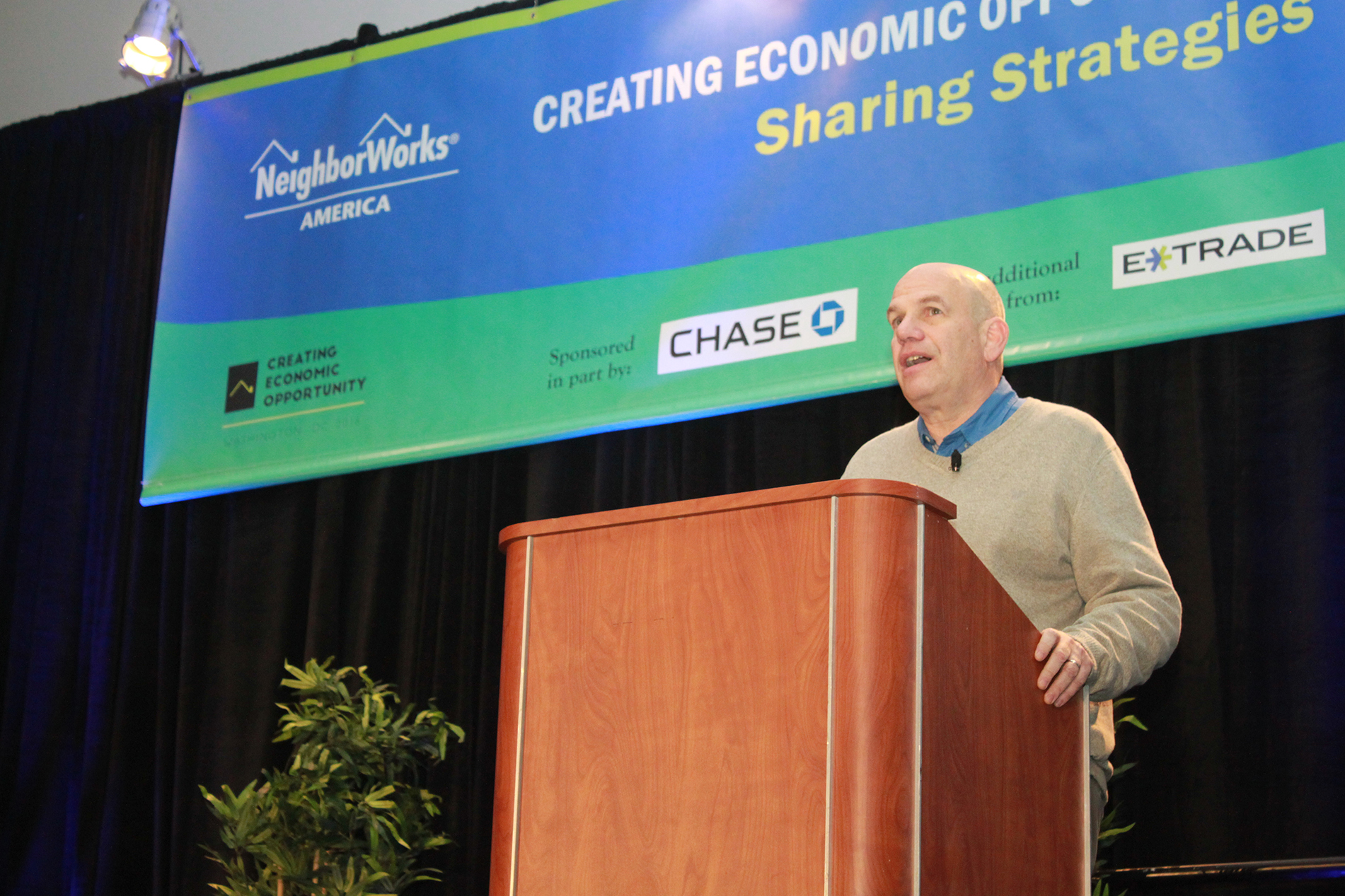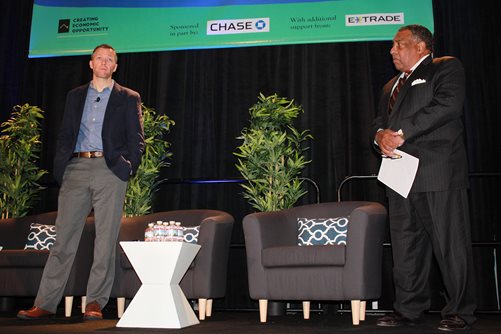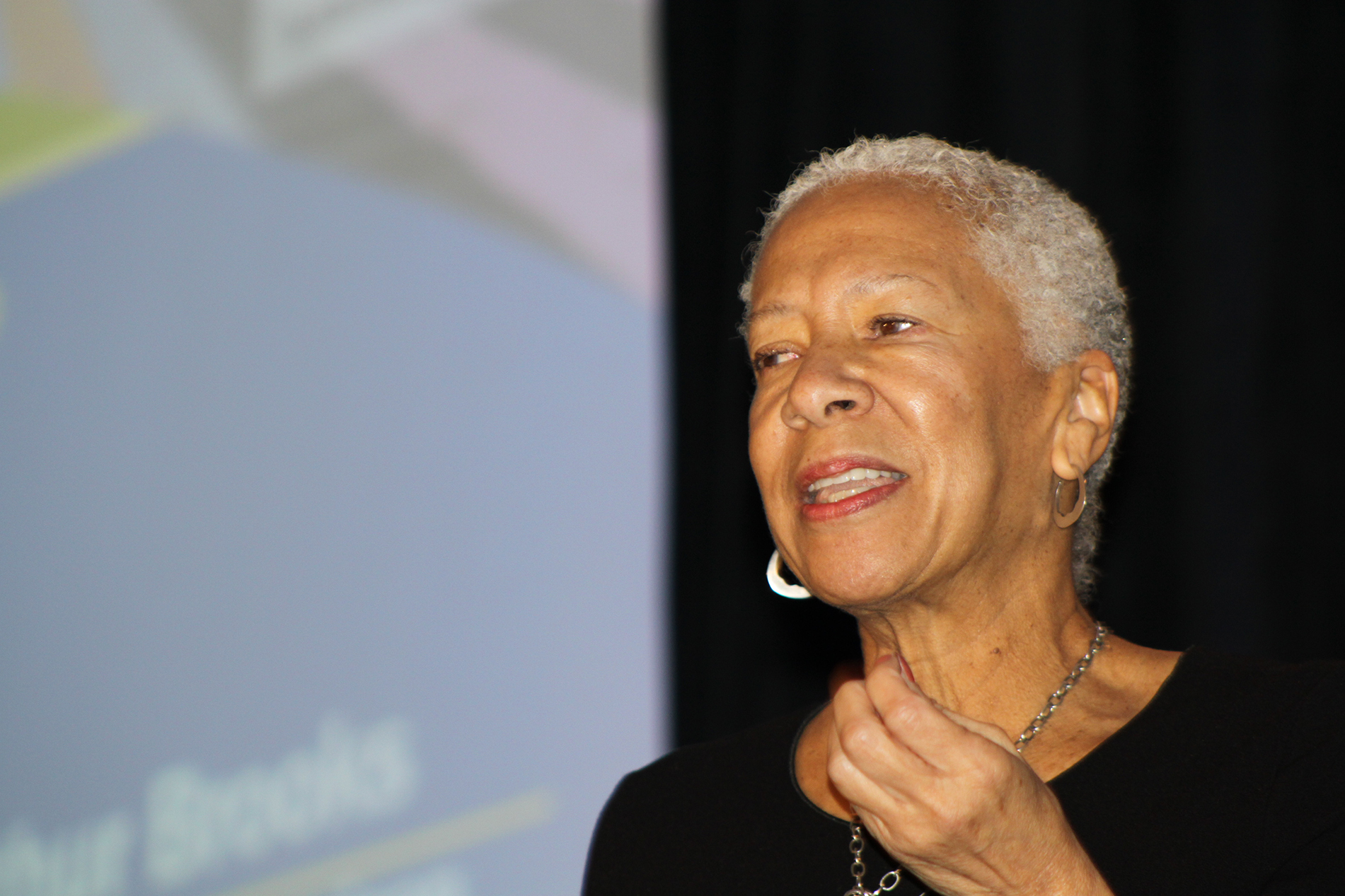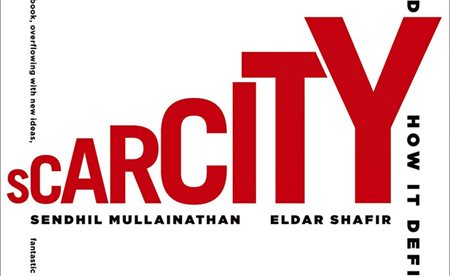“In America today, we are living in two nations. I live about 20 blocks from ‘the corner’ I described in my 1998 book about West Baltimore, which is avoided by most of the city. But it’s another America entirely. It takes a lot of effort to make the journey across the chasm that separates them, but that must be our work.”

Here are a few highlights:
Desmond: Take another look at renter screening
Introducing the first keynote speaker, Harvard University’s Matthew Desmond, retired TV anchor Paul Berry recounted a memory from his childhood. He was 7 years old and living in a home in Detroit when his family was evicted. Fortunately, his grandmother was willing to help, and Berry and his sister moved in with her—from their city house into an Ohio farmhouse with no running water. The change was abrupt and harsh.“I thought I was being punished,” recalled Berry. “I ended up learning to bounce back and even thrive, but I still have the psychological scars left by being forced out of my home.”
That was a fitting story for introducing Desmond, author of “Evicted: Poverty and Profit in the American City.” Remarkably, this book about extremely low-income renters and the impact of evictions has earned a spot on the “best books of 2016” lists issued by everyone from The New York Times, to Amazon, to Buzzfeed.
“Eviction is a cause, not just a condition, of poverty. And it’s leaving a deep and jagged scar on the next generation,” Desmond warned.
In 2013, Desmond documents in his book, 1 in 8 poor renting families nationwide was unable to pay all of their rent, and a similar number thought it was likely they would be evicted soon. In Milwaukee—the typical American city where he did his research—roughly a quarter of all moves by its poorest renters are involuntary. Why? The majority of these renters are spending at least 50 percent of their income on housing; if you add in electricity, its 70 percent of what money they have.
“In situations like this, you don’t need to make a huge mistake to get evicted. There’s no extra money for anything,” he told the audience.

Desmond cited the story of one woman from his book, named Arlene, to illustrate the many reasons a person or family is evicted that could have been avoided with a little emergency assistance or that have nothing to do with financial stability. For example, one of her evictions resulted when her 14-year-old son threw a snowball at a car, and when the driver chased him, he kicked in the door. The landlord evicted them for damaging property.
Desmond also called for a re-examination of one of society’s “sacred cows’: the mortgage interest deduction. The nation is spending more money on homeowner tax benefits than on the departments of education, veterans affairs, homeland security, justice and agriculture combined—and yet most of the benefits go to families with six-figure incomes.
“I’m encouraged by the conversation that’s taking place as a result of my book,” Desmond said. “The problem is getting so big that a coalition is forming. Educators are understanding that students need a stable home to go back to when their studies are done if they are to learn. And employers now know that too many potential employees can’t afford to live close by and thus can’t get there. And then there is the issue of physical health; unstable housing is directly correlated to poor health.”
More humane screening works on the ground
In a following discussion, Peggy Hutchison, CEO of the Primavera Foundation in Tucson, Arizona, described her organization’s “non-transactional” approach to its screening of potential tenants.“We don’t have any hard-and-fast criteria that exclude a person [other than required income restrictions],” said Hutchison. “Our focus is on overcoming barriers.”
Primavera, which also works to re-integrate ex-offenders into its communities, educates tenants on their rights, cross-trains leasing managers and resident-services staff, provides assistance with finding employment and allows its leases to be terminated with just 30 days’ notice.
Steven Kirk, president of Rural Neighborhoods in Florida City, Florida, says his organization relies on home assessments rather than credit scores and references from previous landlords.
“But one of our challenges is how to expand our reach, bring it to scale, so we can serve the people highlighted by Matthew Desmond, who have extremely low incomes,” noted Kirk.
Progressives, conservatives agree: Jobs key
In a point-counterpoint style of discussion, Arthur Brooks, president of the American Enterprise Institute, joined Angela Glover Blackwell, CEO of Policy Link, to discuss what could lead to positive, lasting change in distressed communities.A common focus that emerged was the central role played by employment to all aspects of well-being, including stable housing.
“When I was a kid, I remember people being alarmed because 7 percent of working-age men in our country were idle instead of being in the workforce. Today , it’s 18 percent,” noted Brooks. “We’ve basically communicated to them that they are not necessary to our economy. But idleness is bad for our country’s GDP and bad morally. A sense of being ‘needed’ is the basis of dignity. In fact, I’d say what our country suffers most from is a ‘dignity gap’; we need a radical equality of human dignity. Let’s work to make everybody necessary.”

“I grew up when you didn’t have to have a college education to secure a middle-class job. But that’s not true anymore,” she said. “A job doesn’t necessarily get you out of poverty. If we don’t support people of color to move them into the middle class, there will be no middle class in the future. What we need is not necessarily new ideas; what we need is to put those ideas to work at scale. We are not a poor nation and we need to stop acting like one.”
Blackwell called this the “Curb Cut Effect.” Curb cuts were originally mandated to ease travel for people in wheelchairs, but the benefits have been shared by many others—such as those pushing baby strollers or suitcases on rollers. They also serve to orient pedestrians to the correct street-crossing points, which has reduced fatalities.
“When we solve problems for the most vulnerable, we solve them for everyone,” she said.
Nonprofits must help themselves to help others

Greta Harris, president and CEO of the Better Housing Coalition in Richmond, Virginia, described her organization’s “near-death experience,” forcing it to give up several “sacred-cow programs and even people.” Today, however, it has not only survived but thrived by drawing from the private sector for much of its more-targeted staff and striving to be more financially independent through income-generating activities.
“We want to be able to be a policy disruptor, and that means being able to oppose people and entities that are the traditional funders,” she noted. “We don’t want to be dependent on them.”
David Adame’s Chicanos Por La Causa is pursuing independence as well, and has established six different for-profit enterprises—including a collaboration with United Healthcare, in which the nonprofit helps educate its residents on the company’s supplemental Medicare plan. “We look at the areas in which we are working—economic development, health care, education and real estate—and then analyze our supply chain for opportunities,” he explained.
The key, they all agreed, is educating potential partners on the need for collective impact.
“We can’t do everything so we focus on the areas we do best and build a collaboration with others for the rest,” said Josh Simon, executive director of the East Bay Asian Local Development Corp. in Oakland, California. “When you all meet together, things pop out that would not have occurred to any one of us alone. The keys to success are a common agenda, shared measurement, continuous communication and mutually reinforcing activities.”
Shafir: Get inside the heads of your clients
 “We all tend to tend to forget—or fail to understand—the power of the situation,” cautioned Eldar Shafir, PhD, a behavioral scientist at Princeton University and co-author of “Scarcity: Why Having Too Little Means So Much.”
“We all tend to tend to forget—or fail to understand—the power of the situation,” cautioned Eldar Shafir, PhD, a behavioral scientist at Princeton University and co-author of “Scarcity: Why Having Too Little Means So Much.” For example, he points to the public outrage over the behavior of American soldiers at Iraq’s Abu Ghraib prison. The people weren’t necessarily bad; rather, they were put into a situation that would change anyone’s mental outlook and behavior.
“Context trumps almost everything,” he said. “If you give poor people, who struggle 24/7 with the stress of too little money, only financial literacy classes and then send them home, it’s like throwing them into a stormy sea. They will drown.”
Shafir and his co-author, Sendhil Mullainathan, write in their book, "Our first response to many problems is to teach people the skills they lack. But the extra 'bandwidth' that requires comes at a high cost. Scarcity, that subjective sense of having more needs than resources, makes us less insightful, less forward-looking, less controlled. Being poor, for example, reduces a person’s cognitive capacity more than missing one full night of sleep. They are so focused on dealing with their financial challenges today that they can’t focus on anything else. The poor aren’t negligent. People with scarcity are.”
In the book, Shafir offers a range of practical interventions that can help, such as influencing what’s in their “tunnel.” That could mean actions as simple as reminders texted to clients’ telephones a few days before a payment is due.
Simon: So what does this all mean?
“Vulnerable families need to be surrounded; individual interventions aren’t enough,” agreed Simon in his concluding keynote talk. “Jobs often aren’t possible when they are two bus transfers away, for example. But when you see someone who is completely surrounded by support—like is done by the Harlem Children’s Zone—those are the ones who succeed. The challenge, though, is reaching economies of scale.One of Simon’s parting messages to the community development professionals and their partners in the room was to avoid labeling people and to help them break out when they are—not only the evicted, for instance, but ex-offenders who come back into society after years in prison, only to be met by shut doors.
“The people I most admire are those who bounce back after the worst of journeys,” he said. “They become stronger in some sense, and are more capable than we are to understand what is needed to turn others around. But when they apply for grants or attempt to interact with the ‘system’ in some other way, we discount them. My message to you is to value them. Because they are precious.”
Note: Many ways of addressing the challenges highlighted here, as well as others, are included in the new book, "NeighborWorks Works: Practical Solutions from America's Community Development Network"—several of which were featured at a Solutions Expo in the afternoon of the symposium.

